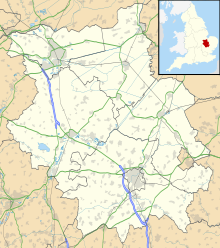RAF Graveley is a former Royal Air Force station located 5 miles (8 km) south of Huntingdon.[1] The station was originally intended to operate under No. 3 Group RAF, alongside RAF Tempsford and RAF Gransden Lodge.
RAF Graveley | |||||||||||||||||||
|---|---|---|---|---|---|---|---|---|---|---|---|---|---|---|---|---|---|---|---|
 Handley Page Halifax B.III | |||||||||||||||||||
| Summary | |||||||||||||||||||
| Airport type | Military | ||||||||||||||||||
| Operator | Royal Air Force | ||||||||||||||||||
| Location | Graveley, Huntingdon, Cambridgeshire | ||||||||||||||||||
| Built | 1941 | ||||||||||||||||||
| In use | 1942–1968 | ||||||||||||||||||
| Elevation AMSL | 174 ft / 53 m | ||||||||||||||||||
| Coordinates | 52°15′47″N 000°11′24″W / 52.26306°N 0.19000°W | ||||||||||||||||||
| Map | |||||||||||||||||||
| Runways | |||||||||||||||||||
| |||||||||||||||||||
Station history edit
Work on the site started in 1941, and it was opened as an operational base in March 1942 with No. 161 Squadron flying Lysander aircraft under No. 3 Group RAF, until it transferred to the Pathfinder Force with No. 35 Squadron in August 1942.[2] Originally, the base was intended for special operations and would have operated alongside RAF Tempsford and RAF Gransden Lodge.[3] No. 35 Sqn (No. XXXV Squadron) arrived in August 1942 using the Handley Page Halifax (which it had used since 1940) it became a pathfinder unit, forming part of No. 8 Group. In March 1944 the squadron re-equipped with the Avro Lancaster and continued at Graveley until it was posted to RAF Stradishall in September 1946.[4] During November 1945, Michael Beetham, then a Squadron Leader, was posted onto the squadron.[5]
In 1943, RAF Graveley was one of the first operational stations to use the fog dispersal system FIDO.[6] It was tested in July of that year with fog being burnt off and visibility vastly increased, though the descending aircraft had to cope with turbulence caused by the heated air from the evaporated fog.[7] In November 1943, the first operational use of the FIDO system saw four Halifax aircraft of No. 35 Sqn landing in fog after a bombing operation.[8]
No. 692 Squadron was formed on 1 January 1944 at RAF Graveley, equipped with Mosquito IV bombers, as part of the Light Night Striking Force of No. 8 Group RAF in Bomber Command.[9] It re-equipped with the Mosquito XVI bombers in March.[10]
No. 227 Squadron moved to Graveley from Strubby in June 1945, and was disbanded here on 5 September 1945.[11]
Post-war, the airfield was used as a relief landing ground for No. 206 Advanced Flying School and No. 5 Flying Training School which were based at RAF Oakington.[12][13] The airfield was closed in December 1968.[14]
In popular culture edit
Part of the filming for the 1967 movie picture "'Robbery" (which was based on the Great Train Robbery) was filmed at the airfield with a number of exterior shots showing parts of the airfield.[1] A few of the buildings shown in the film where the control tower was located still exist.
Current use edit
The airfield is mostly agriculture with a few buildings surviving.[1] A wind farm was built on the site in the 2010s.[15]
References edit
- ^ a b c "RAF Graveley". Control Towers. Retrieved 9 May 2012.
- ^ "RAF Graveley". ibccdigitalarchive.lincoln.ac.uk. Retrieved 31 December 2021.
- ^ Sullivan, Chris (2015). Trials and tribulation : the story of R.A.F. Gransden Lodge. Kibworth Beauchamp: Troubadour. p. 3. ISBN 978-1784622336.
- ^ Jefford 2001, p. 40.
- ^ Jacobs, Peter (2011). Stay the distance : the life and times of Marshal of the Royal Air Force Sir Michael Beetham. London: Frontline Books. p. 54. ISBN 978-1848325524.
- ^ Osborne, Mike (2013). Defending Cambridgeshire : the Military Landscape from Prehistory to Present. Stroud: The History Press. p. 113. ISBN 978-0752497525.
- ^ Eden, Philip (2003). The Daily Telegraph book of the weather. New York: Continuum. p. 112. ISBN 0826471250.
- ^ Bowyer, Chaz (1984). Royal Air Force handbook, 1939-1945. London: I. Allan. p. 126. ISBN 0711013187.
- ^ Lake 1999, p. 276.
- ^ Jefford 2001, p. 106.
- ^ "No. 227 Squadron (RAF): Second World War". History of War. Retrieved 1 April 2018.
- ^ Lake 1999, p. 106.
- ^ "Stations-G". rafweb.org. Retrieved 31 December 2021.
- ^ "Graveley – Airfields of Britain Conservation Trust UK". abct.org.uk. Retrieved 31 December 2021.
- ^ Davies, Debbie (10 December 2015). "Wind Farm campaigners will fight on despite council ruling on noise nuisance". Hunts Post. Retrieved 31 December 2021.
Sources edit
- Jefford, C. G. (2001). RAF squadrons : a comprehensive record of the movement and equipment of all RAF squadrons and their antecedents since 1912 (2 ed.). Shrewsbury: Airlife. ISBN 1-84037-141-2.
- Lake, Alan (1999). Flying units of the RAF : the ancestry, formation and disbandment of all flying units from 1912. Shrewsbury: Airlife. ISBN 1-84037-086-6.
